- Cocos2D for iPhone 0.99 Beginner’s Guide
- Cocos2d for iPhone 1 Game Development Cookbook
- Learn cocos2d Game Development with iOS 5
- Learn iPhone and iPad cocos2d Game Development
- Learning Cocos2D: A Hands-On Guide to Building iOS Games with Cocos2D, Box2D and Chipmunk
- iPhone Cool Projects (**)
- Pro iOS 5 Augmented Reality (**)
- cocos2d-x手机游戏开发:跨iOS、Android和沃Phone平台(*)
This post contains affiliate links; this means if you make a purchase after following one of our links, we may be paid a small commission at no cost to you.
(*) cocos2d-x based, in Chinese
(**) Only partial content about Cocos2d
Cocos2d for iPhone 0.99 Beginner’s Guide |
|||||||||||||||||||||
|
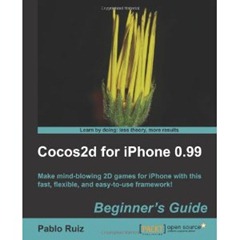 |
||||||||||||||||||||
| Table of Contents: | |||||||||||||||||||||
|
|||||||||||||||||||||
| Publishers Description: | |||||||||||||||||||||
What you will learn from this book
|
|||||||||||||||||||||
|
|
|||||||||||||||||||||
Cocos2d for iPhone 1 Game Development Cookbook |
|||||||||||||||||||||
|
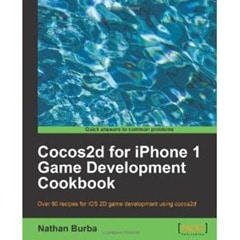 |
||||||||||||||||||||
| Table of Contents: | |||||||||||||||||||||
|
|||||||||||||||||||||
| Publishers Description: | |||||||||||||||||||||
What you will learn from this book
|
|||||||||||||||||||||
|
|
|||||||||||||||||||||
Learn cocos2d Game Development with iOS 5 |
|||||||||||||||||||||
|
 |
||||||||||||||||||||
| Table of Contents: | |||||||||||||||||||||
|
|||||||||||||||||||||
| Publishers Description: | |||||||||||||||||||||
| Create compelling 2D games with Learn cocos2d Game Development with iOS 5. This book shows you how to use the powerful cocos2d game engine to develop games for iPhone and iPad with tilemaps, virtual joypads, Game Center, and more.
It teaches you:
Best of all, Learn cocos2d Game Development with iOS 5 will have you making games right from the very start. It guides you step-by-step through the creation of sample games. These fun examples are modeled after popular App Store games and teach you key concepts of the cocos2d game engine and relevant tools like TexturePacker (texture atlas), PhysicsEditor (physics collision shapes), Particle Designer (particle effects), Glyph Designer (bitmap fonts), and others. This book offers a rock-solid introduction to creating games made entirely with cocos2d and little or no iOS 5 SDK and OpenGL code. It also details alternative implementations, identifies the best free and commercial tools for cocos2d game development, features coverage of the author’s improved cocos2d game engine (Kobold2D), and even helps you enhance your game’s marketability on the App Store. What you’ll learn
|
|||||||||||||||||||||
|
|
|||||||||||||||||||||
Learn iPhone and iPad cocos2d Game Development |
|||||||||||||||||||||
|
 |
||||||||||||||||||||
| Table of Contents: | |||||||||||||||||||||
|
|||||||||||||||||||||
| Publishers Description: | |||||||||||||||||||||
| Note, appears to be earlier version of Learn cocos2d Game Development with iOS 5
Learn iPhone and iPad cocos2D Game Development provides a rock-solid introduction to the cocos2d iPhone game engine and related tools. It focuses on the process of creating several games made entirely with cocos2d and little-to-no iPhone SDK and OpenGL code. By creating 2-3 sample games over the course of the book, you’ll learn key concepts of the cocos2d game engine and relevant tools like Zwoptex (TextureAtlas), ParticleDesigner (Particle Effects), and others. The example games are modeled after popular App Store games so that they are relevant, recognizable, and immediately fun and inspiring. The games increase in complexity and highlight common recurring cocos2d beginner questions. As you move along, you’ll learn about possible stumbling blocks and how to navigate them successfully. As you move from beginning to advanced, you’ll encounter general game programming wisdom, tips for performance improvement, as well as pointers to alternative implementations and further reading. It is assumed that the reader has previous programming knowledge but not necessarily with Objective-C. Related topics such as Xcode, Objective-C, the iPhone SDK, and OpenGL are only discussed where absolutely necessary. What you’ll learn
|
|||||||||||||||||||||
|
|
|||||||||||||||||||||
Learning Cocos2D: A Hands-On Guide to Building iOS Games with Cocos2D, Box2D, and Chipmunk |
|||||||||||||||||||||
|
 |
||||||||||||||||||||
| Table of Contents: | |||||||||||||||||||||
|
|||||||||||||||||||||
| Publishers Description: | |||||||||||||||||||||
| Cocos2D is the powerhouse framework behind some of the most popular games in the App Store. If you’ve played Tiny Wings, Angry Birds, Mega Jump, Trainyard, or even Super Turbo Action Pig,then you’ve played a game that uses Cocos2D or Box2D physics. The beauty of Cocos2D is its simplicity. It’s easy to become overwhelmed when you start developing an iOS game, especially if you look at things like OpenGL ES, OpenAL, and other lower level APIs. Writing a game for the iPhone and iPad does not have to be that difficult, and Cocos2D makes game development fun and easy.
Learning Cocos2D walks you through the process of building Space Viking (which is free on the App Store), a 2D scrolling game that leverages Cocos2D, Box2D, and Chipmunk. As you build Space Viking, you’ll learn everything you need to know about Cocos2D so you can create the next killer iOS game. Download the free version of Space Viking from the App Store today! Help Ole find his way home while learning how to build the game. As you build Space Viking, you’ll learn how to
|
|||||||||||||||||||||
|
|
|||||||||||||||||||||
iPhone Cool Projects |
|||||||||||||||||||||
|
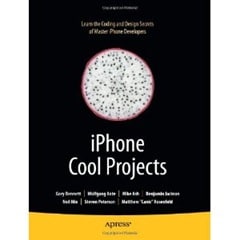 |
||||||||||||||||||||
| Table of Contents: | |||||||||||||||||||||
|
|||||||||||||||||||||
| Publishers Description: | |||||||||||||||||||||
| The iPhone and iPod touch have provided all software developers with a level playing field—developers working alone have the same access to consumers as multinational software publishers. Very cool indeed! To make your application stand out from the crowd, though, it has to have that something extra. You must learn the skills to take your apps from being App Store filler to download chart-topping blockbusters.
Developers with years of experience helped write this book. Spend some time understanding their code and why they took the approach they did. You will find the writing, illustrations, code, and sample applications second to none. No matter what type of application you are writing, you will find something in this book to help you make your app that little bit cooler. The book opens with Wolfgang Ante, the developer behind the Frenzic puzzle game, showing how timers, animation, and intelligence are used to make game play engaging. It moves on to Rogue Amoeba’s Mike Ash explaining how to design a network protocol using UDP, and demonstrating its use in a peer-to-peer application—a topic not normally for the faint of heart, but explained here in a way that makes sense to mere mortals. Gary Bennett then covers the important task of multithreading. Multithreading can be used to keep the user interface responsive while working on other tasks in the background. Gary demonstrates how to do this and highlights traps to avoid along the way. Next up, Canis Lupus (aka Matthew Rosenfeld) describes the development of the Keynote-controlling application Stage Hand, how the user interface has evolved, and the lessons he has learned from that experience. Benjamin Jackson then introduces two open source libraries: cocos2d, for 2D gaming; and Chipmunk, for rigid body physics (think “collisions”). He describes the development of Arcade Hockey, an air hockey game, and explains some of the code used for this. Neil Mix of Pandora Radio reveals the science behind processing streaming audio. How do you debug what you can’t see? Neil guides you through the toughest challenges, sharing his experience of what works and what to watch out for when working with audio. Finally, Steven Peterson demonstrates a comprehensive integration of iPhone technologies. He weaves Core Location, networking, XML, XPath, and SQLite into a solid and very useful application. Software development can be hard work. Introductory books lay the foundation, but it can be challenging to understand where to go next. This book shows some of the pieces that can be brought together to make complete, cool applications. What you’ll learn
|
|||||||||||||||||||||
|
|
|||||||||||||||||||||
Pro iOS 5 Augmented Reality |
|||||||||||||||||||||
|
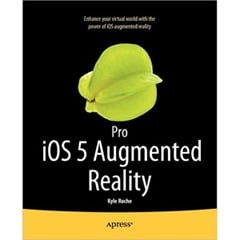 |
||||||||||||||||||||
| Table of Contents: | |||||||||||||||||||||
|
|||||||||||||||||||||
| Publishers Description: | |||||||||||||||||||||
| Augmented reality takes the real world and through the use of graphics, sound and other effects allows you to enhance the environment. It makes a game more real. Your social media app puts you where want to be or go.
Pro iOS 5 Augmented Reality walks you through the foundations of building an augmented reality application for the iPhone or iPad. From using MapKit, to the accelerometer and magnetometer, to integrating facial recognition and Facebook data, you’ll learn the building blocks of creating augmented reality applications. Case studies are included in this one-of-a-kind book and you’ll learn how to create augmented reality apps that unleash the full potential of the on-board sensors and camera. This book complements other iOS game or social media apps development books available from Apress. After reading Pro iOS 5 Augmented Reality, you’ll be able to build augmented reality rich media apps or integrate all the best augmented reality techniques and tools into your existing apps. What you’ll learn
|
|||||||||||||||||||||
|
|
|||||||||||||||||||||
cocos2d-x手机游戏开发:跨iOS、Android和沃Phone平台 |
|||||||||||||||||||||
|
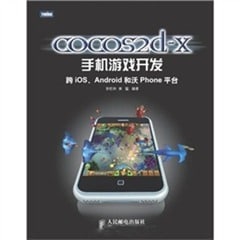 |
||||||||||||||||||||
| Publishers Description: | |||||||||||||||||||||
| 《cocos2d-x手机游戏开发:跨iOS、Android和沃Phone平台》共有12章,以跨平台的手机游戏开发为主线,围绕着cocos2d-x引擎,由浅入深地讲解了智能手机的游戏开发过程、跨平台游戏引擎的原理、跨平台游戏引擎周边工具以及跨平台的游戏开发,还给出了完整的实战案例,语言简洁,结构清晰。《cocos2d-x手机游戏开发:跨iOS、Android和沃Phone平台》适合所有想进入智能手机平台游戏领域的人士,包括在校大学生、游戏开发者和网络游戏公司的CTO等。
|
|||||||||||||||||||||
|
|
|||||||||||||||||||||
